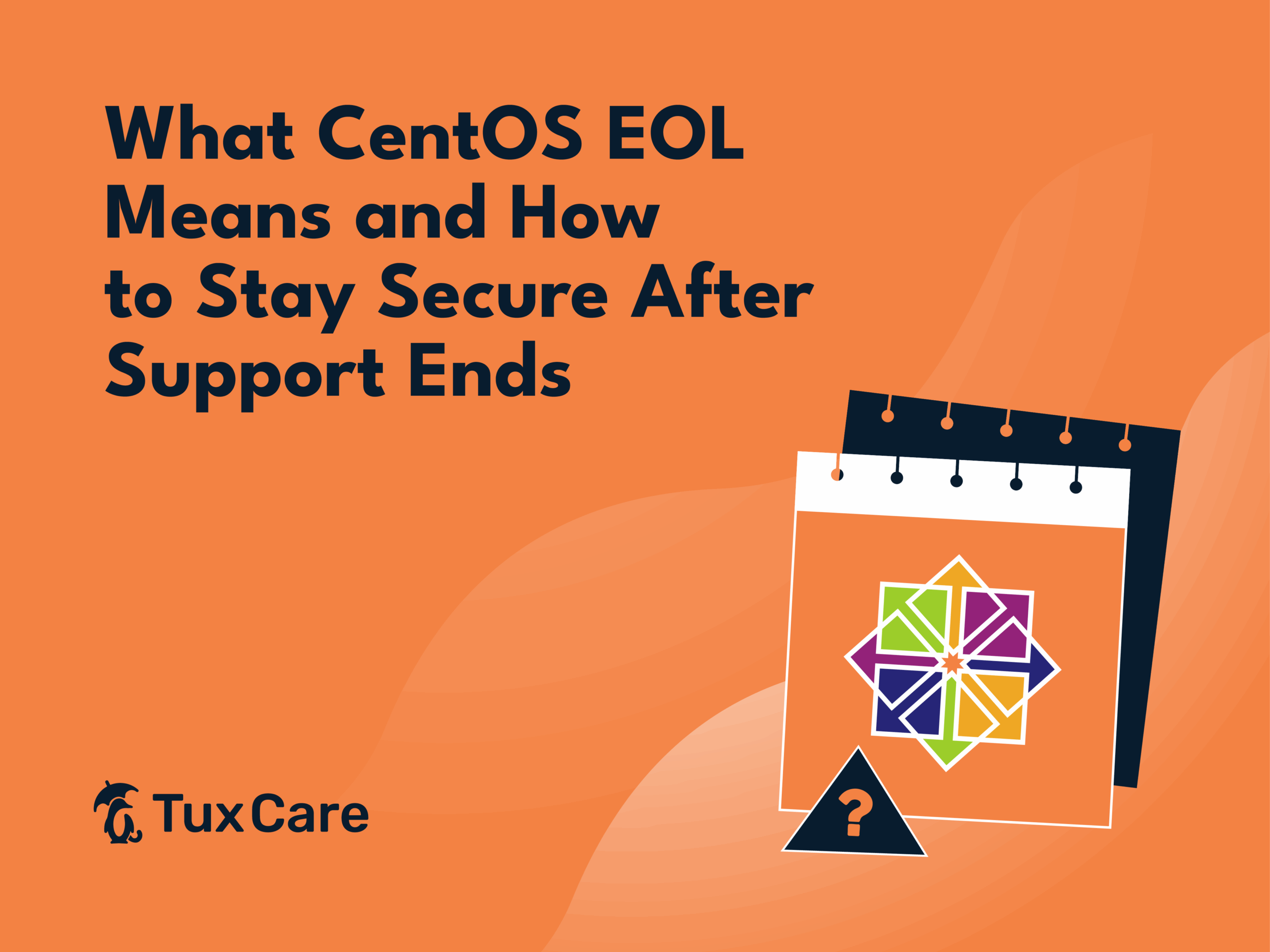Key Takeaways
- CentOS 6, 7, and 8 no longer receive security updates, leaving systems exposed and unsafe for production use.
- You have two options — migrate to alternatives like AlmaLinux or Rocky Linux, or apply extended support to stay protected.
- TuxCare’s Endless Lifecycle Support (ELS) provides ongoing security patches for CentOS EOL systems beyond their vendor-supported lifecycle.
CentOS Linux has been discontinued and is no longer supported by the vendor. If you’re still running CentOS 6, 7, or 8, your systems face serious security and compliance risks.
This article breaks down what CentOS EOL means, the dangers of running unsupported systems, and how you can stay protected even after official support ends.
What Does CentOS EOL Mean?
CentOS End of Life (EOL) means the operating system no longer receives updates from the CentOS Project — no security patches, no bug fixes, no performance improvements. Your system is frozen in its last known state, with every new vulnerability left unpatched. As of now, all CentOS Linux versions have reached the end of life.
|
CentOS Release |
End-of-Life Date |
|
CentOS 6 |
November 30th, 2020 |
|
CentOS 7 |
June 30th, 2024 |
|
CentOS 8 |
December 31st, 2021 |
Why Was CentOS Linux Discontinued
Red Hat discontinued CentOS Linux to shift focus to CentOS Stream, which now serves as the upstream development branch for RHEL.
CentOS Linux was previously a stable, free downstream rebuild of RHEL — widely used for production environments. However, this free RHEL clone model no longer aligned with Red Hat’s business goals. As a result, CentOS 8’s support ended in 2021, years earlier than expected, and the CentOS Linux project was officially phased out.
Why Was CentOS Linux Replaced by CentOS Stream?
CentOS Stream is a more development-focused platform and gets updates and features before they’re fully tested for RHEL. This makes it less stable and predictable than CentOS Linux, which was a downstream, production-ready clone of RHEL.
Red Hat introduced CentOS Stream to allow more community involvement in RHEL development. But, in doing so, CentOS shifted from a stable OS to a testing ground, which doesn’t meet the needs of users who relied on long-term stability.
Alternatives
If you need a secure, stable CentOS replacement, here are your top options:
AlmaLinux: A free, drop-in replacement for CentOS users seeking a long-term stability. Backed by CloudLinux.
Rocky Linux: Created by a CentOS co-founder, Rocky offers long-term support and 1:1 RHEL-compatibility.
Oracle Linux: Free to use and RHEL-compatible. Offers optional commercial support, commonly used in Oracle-based environments.
RHEL (Red Hat Enterprise Linux): The commercial source of CentOS. Offers full vendor support and enterprise features.
Why Patching CentOS Systems After EOL Is Critical
Once an operating system hits End of Life (EOL), security patches stop completely. That leaves your systems exposed to known vulnerabilities — with no defenses in place. These unsupported systems are easy targets for attackers and put you at serious risk of breaches, downtime, and compliance failures.
Increased Attack Surface
Unpatched EOL systems become low-hanging fruit. Any newly discovered vulnerabilities remain open for exploitation. These systems are frequently targeted by automated scans and malware, making breaches far more likely.
Compliance Violations
Many regulatory frameworks require that businesses maintain up-to-date software as part of their compliance. Running unsupported CentOS versions can result in failed audits, costly fines, or legal consequences — even if the system seems to be running fine.
Operational Instability
EOL systems often face compatibility issues with newer hardware and software, leading to performance degradation, unexpected crashes, or downtime.
For example, modern hardware may lack the drivers or kernel support required by older CentOS versions. Eventually, you’ll hit a point where nothing can be upgraded safely, forcing a rushed migration under pressure.
Your Options After CentOS EOL
For organizations still relying on CentOS, securing their systems becomes significantly more challenging.
While ignoring this situation (“doing nothing”) might seem like a temporary solution, it’s a dangerous gamble that exposes organizations to substantial security risks and potential business disruption.
Organizations must choose between two main options: migrating to a supported operating system or leveraging extended support for continued security updates. Migration is the long-term fix, but it’s not always possible right away. Here’s what each path involves.
Migration Considerations
Switching to alternative distributions like AlmaLinux or Rocky Linux is a common recommendation. These community-driven distributions aim for compatibility with RHEL and offer a long-term solution.
However, migrations are rarely simple. They often require detailed planning, testing, and execution, which can consume significant time and resources. This often makes immediate migration an impractical solution for many businesses.
Follow our CentOS Migration Guide: A Seamless Shift to AlmaLinux to ensure a smooth transition.
Extended Support
If migration isn’t an option right now, extended support offers a lifeline by providing vulnerability patches for EOL systems. TuxCare’s Endless Lifecycle Support (ELS) offers ongoing patches for CentOS 6, CentOS 7, and CentOS 8, helping you maintain a secure and compliant environment without rushing through a migration process.
This approach is particularly valuable for businesses that need time to plan and execute a carefully managed migration strategy or for those with mission-critical applications that cannot be easily migrated.
How TuxCare Helps You Secure CentOS After EOL
TuxCare offers a reliable, cost-effective way to keep your end-of-life CentOS systems secure without rushing migration.
With ongoing vulnerability patching, TuxCare helps organizations maintain compliance, reduce risk, and avoid downtime — even after official support has ended.
What Is TuxCare’s Endless Lifecycle Support?
TuxCare’s Endless Lifecycle Support (ELS) is an extended support service that provides ongoing security patches for Linux distributions, programming languages, and development frameworks that have reached End of Life (EOL).
Patches are delivered through TuxCare’s secure ELS repositories, and setup is simple — just run a single command to switch your system’s existing repositories. Once configured, your systems will continue to receive critical security updates, reducing the risks of running unsupported software.
Currently supported Linux distributions include:
- CentOS 6, CentOS 7, CentOS 8
- CentOS Stream 8
- Oracle Linux 6, Oracle Linux 7
- Ubuntu 16.04, Ubuntu 18.04, Ubuntu 20.04
Supported Packages and Versions
TuxCare’s ELS covers critical packages across CentOS 6, 7, and 8, including the Linux kernel, OpenSSL, glibc, Python, OpenJDK, Apache, and more. The goal is to cover the components that directly affect security, system stability, and compliance. Check out the full list of supported packages here.
Benefits of Choosing TuxCare vs. Other Solutions
Simple Setup: Deploying TuxCare’s ELS is easy — just run a single command to switch your repositories.
Endless Security Coverage: Receive ongoing vulnerability patches for as long as you need after official vendor support ends.
Broad Package Support: Includes hundreds of commonly used CentOS packages across versions 6, 7, and 8.
Expert Technical Assistance: Get 24/7 break/fix support and help with your CentOS migration strategy.
Affordable Pricing: Starts at just $4.25/month or $42.50/year per system.
Your Next Move After CentOS EOL
As we’ve covered, taking no action is not a safe option. The risks, from unpatched vulnerabilities to compliance headaches, are just too big to ignore.
If you’re still operating on CentOS 6, 7, or 8, now is the time to either begin migrating to supported alternatives like AlmaLinux or Rocky Linux, or implement extended support to secure your systems.
Start your migration journey with our step-by-step CentOS 7 Migration Guide, or reach out to TuxCare’s Linux security experts to explore how Endless Lifecycle Support (ELS) can protect your CentOS systems — and get guidance for a smooth, secure transition.



 Documentation
Documentation Login
Login





